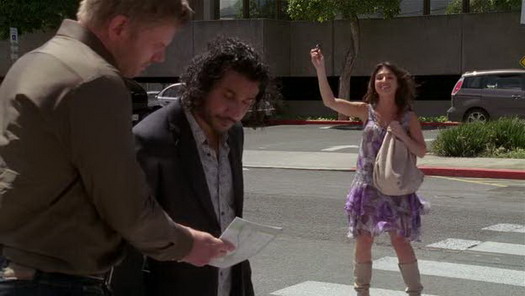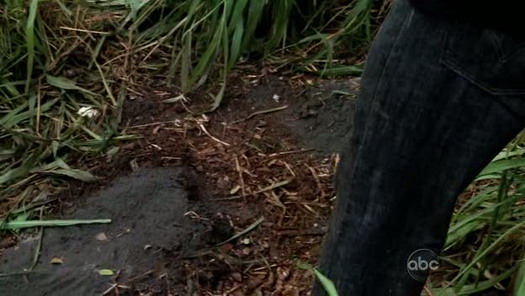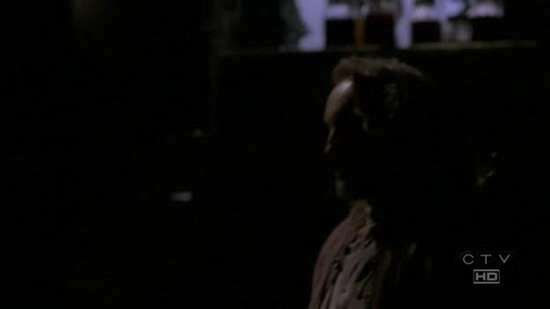As Long as Somebody Pays for It
Whatever Jacob’s goal is, and despite Esau apparently finding his loophole, the former appears willing to die for it, much like Jesus sacrificed himself on the cross for all humanity’s sins. We shift to a flashback in Iowa, as Kate and friend attempt to shoplift a fancy New Kids On The Block lunchbox.
They’re caught red-handed and the store owner is about to call the cops on ’em. Jacob intervenes and gets them off by paying for the lunchbox. As the general store owner aptly puts it in the Kate-stealing-lunchbox flashback, “as long as somebody pays for it,” all will be forgiven. Jacob’s willing to pay the price.
Take Me Home
I’d mentioned in a previous recap of a Sayid-centric episode that his backstory had pretty much been completed. Well, almost, as tonight reveals just how Nadia died. A hit & run collision with a Jeep ends her life. Who was driving that Jeep? Or was it simply an accident? Either way, Jacob knew what was coming and prevented Sayid from meeting the same fate.
We also learn why Sayid traveled all the way to Iraq to bury the love of his life: her dying words are, “take me home.”
Home, Sweet Home
The ultimate power behind the Island finally returns!
Vincent bounds out of the jungle to welcome Sawyer, Juliet and Kate back to the Island after their brief pleasure cruise aboard the sub. And in tow are none other than Rose and Bernard, who we’ve not seen since I can’t remember when.
Bernard, looking quite like Moses, and Rose have “retired” to a quiet hut in the jungle, living off the Dharma foodstuffs likely scattered all over the Island by now. (Maybe they’re raiding the continuing food drops?) They may have the right idea not getting involved in the utter mess the rest of the castaways find themselves in.
Burnin’ Down the House
Ilana and the cult-like worshippers she leads carry that cargo box, the contents of which Lapidus calls “terrific,” across the Island to Jacob’s cabin. We’ve wondered just what that barrier was that surrounded the place, and Bram confirms it as being ash.
Said boundary has been breached, meaning whatever it held captive within its perimeter is now free to roam the Island. We’ve always assumed the figure Locke glimpsed in the chair a few seasons ago to be Jacob, but does that really add up, knowing what we know now?
Jacob’s likely been living in “the shadow of the statue” for some time now, so who is the guy above? My guess, and a logical one methinks, is Esau. Jacob found some way to keep him holed up in the cabin while he continued bringing new folks to the Island. The ethereal “help me” Locke hears during that scene now has some context as well. Esau wants Locke’s help to escape his prison.
Whatever the truth happens to be, Ilana and her merry men seem to know Jacob is no longer residing in the dilapidated cabin, and that someone else was using it, but has vacated the premises. Might as well burn the place down.







Great stuff!!! Loved the finale and all the questions it answered/raised. These writers have tied in so many different philosophical sources (The Bible, Mythology, Physics, etc)that it makes me think their IQ’s are off the charts. I don’t think we will be disappointed. Matthew Fox on Jimmy Kimmel thinks we will be very satisfied. Thanks, Jeff. Great write up!
Well done! Love the Esau and Jacob connection – I didn’t think of it like that. I too got weirded out when “Esau” mentioned he had just eaten. Hmmmm…
Always fun to come and read your recaps Jeff. Can’t wait until next season 🙂
great recap as always meng.
Richard’s answer to “What lies in the shadow of the statue” – “He who will save us all”
via Lostpedia
Many Bible parables…Prodigal son, raising Lazarus from the dead, allowing Zacheaus to “rise up and walk”, etc….I am wondering if each of the castaways has a correlated character from the miracles Jesus(Jacob) pulls from the Bible..water into wine, the widow at the well, etc.
Thanks for all the recaps! They are always absolutly amazing!
Hmmm… your interpretation for Jacob’s intervention in the castaways’ lives is quite interesting; I actually think the exact opposite: I’m not entirely sure that Jacob is quite as “good” as we’re being led to believe. In fact, with the exception of Jack, I understood he actually pushes all of them to take a certain step that will have a major significance in their lives, in a most negative way. Let’s see:
• He gives James a pen so he can keep writing his letter. The same letter that James’ uncle or whatever makes look like a symbol for James’ unhealthy fixation with old Sawyer, a fixation that effectively prevents him from moving on with his life and ultimately corrupts him, turning him into the new Sawyer.
• He pays for the lunchbox Kate and What’s-His-Name will use as a time capsule. Digging up that time capsule was the moment in which they sort of made the ultimate re-connection, so the time capsule might very well be to blame for What’s-His-Name death.
• He stops Sayid from crossing the street with Nadia, therefore she needs to stop and turn around in order to talk to him, which puts her smack dab in the way of the car.
Hmmmmm… come to think of it, I can’t quite “negativize” the rest of the encounters so easily. But still, I’m suspicious of that guy.
You can’t trust a person who doesn’t change his hairdo in 200 years… ¬__¬
Seriously, though, if we stick to the Jacob & Esau interpretation (which I wholeheartedly do), we might remember that as one story in which nothing is quite clearly white nor black. Jacob spends his entire life making all kinds of sneaky, dirty passes on Esau in order to rob him of all his firstborn rights (from the very moment of their birth), but then he’s actually making God’s will by doing that. In fact, as much of a sneaky bastard as he seems to be, he’s actually the patriarch of the 12 tribes.
Point being, Jacob’s being sold to us as too good to be true, and suddenly I feel the entire point of making so many references to the black vs. white duality will be to ultimately show that there are a lot of greys inbetween…
I certainly can’t argue with any of that; all good points.
when is the video of chang taken by faraday supposed to have occurred? i am confused by this.
The last official podcast indicates that video should no longer be considered canon.
They had some elaborate plans for their alternate-reality game on the Internet that would’ve incorporated that, but it got shelved by ABC because of the economy.
I thought the same thing about Nadia getting hit by the bus….that Jacob wanted her to die more than he wanted to “touch” Sayid
Just now watched the finale online – remarkable! And, Jeff, was most anxious to read your write up – as always, not disappointed and thoroughly impressed!
M’comment: if we go with Jacob = Jesus; then all those he touched/brought to the island are the/his-Jesus’ 12 disciples.
i’ve lurked you’re blog for the past few seasons, always fun and a great read & can’t wait until 2010 to ‘watch it go to fire’
ps : i checked imdb’s long list of cast members and didnt see jacob listed anyone know the actor’s name? i recognize him from another role and it’s driving me bonkers
Mark Pellegrino
http://lost.cubit.net/archives/2009/05/abc-officially-reveals-statues.php#more
According to the most recent recap at ABC.com, the statue is in fact Taweret. I know, I know, many of you saw this from the very first moment we caught a glimpse at the back of the statue, so go ahead and use the comments below to proclaim your brilliance, cleverness, and aptitude for figuring out the mysteries of Lost, something I obviously suck at.
And now, a little about Taweret. Wikipedia has this to say about the Egyptian Goddess:
Her name means (one) who is great. When paired with another deity, she became the demon-wife of Apep, the original god of evil. Since Apep was viewed as residing below the horizon, and only present at night, evil during the day then was envisaged as being a result of Taweret’s malfeasance.
As the counterpart of Apep, who was always below the horizon, Taweret was seen as being the northern sky, the constellation roughly covering the area of present-day Draco, which always lies above the horizon. Thus Taweret was known as mistress of the horizon, and was depicted as such on the ceiling of the tomb of Seti I in the Valley of the Kings.